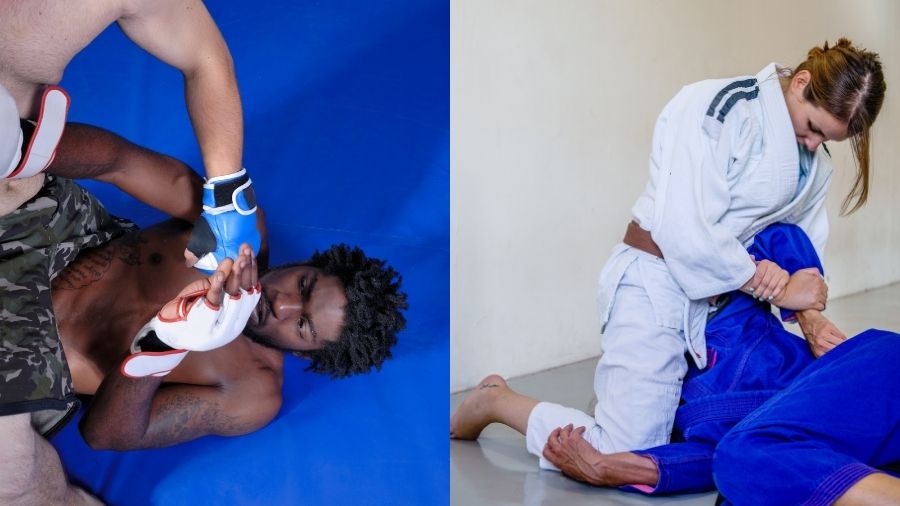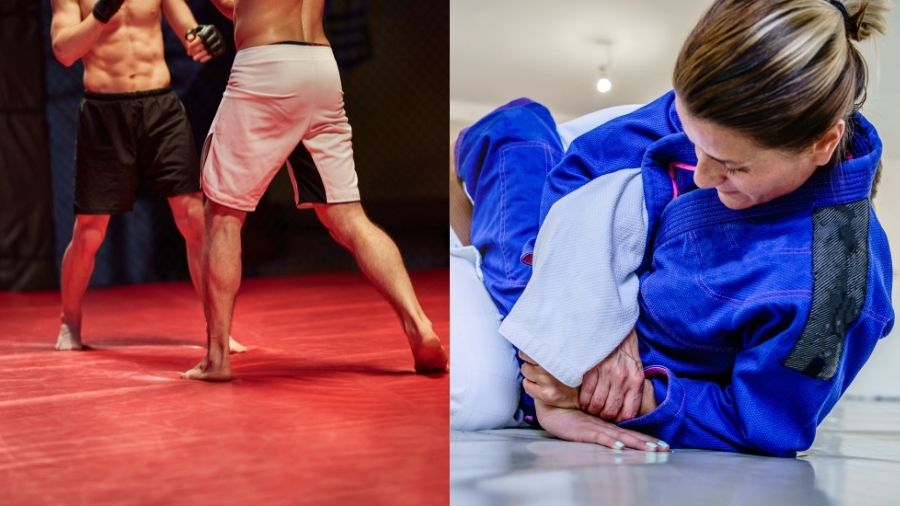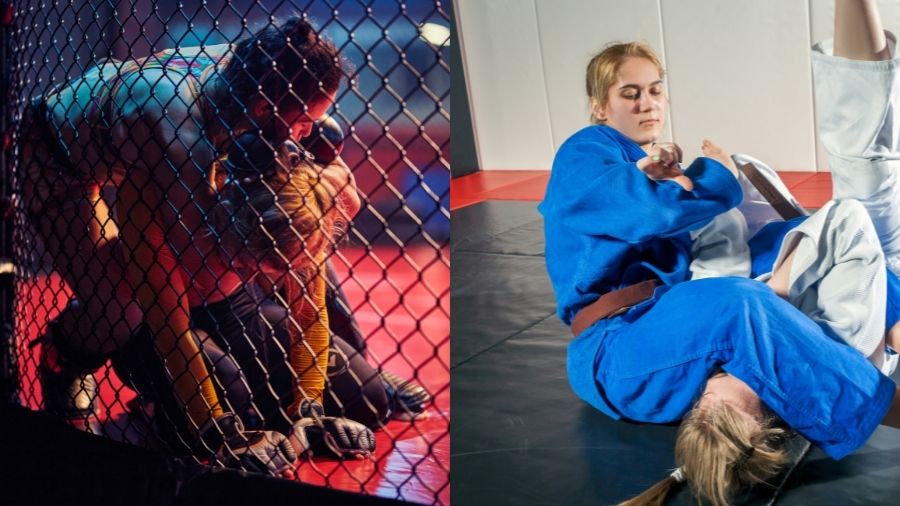Whether you should train a martial art is a rhetorical question with a clear YES, as an answer. But to choose one of the countless arts can be a very daunting task. With a myriad of styles ranging from soft form traditional martial arts to self-defense-oriented classes, you have a vast choice if you live in a big city.
Brazilian jiu-jitsu is a grappling-based martial art that is highly specialized and is a critical aspect of MMA. In contrast, mixed martial arts is a complete combat system encompassing all aspects of unarmed combat- striking, wrestling, and grappling.
Both MMA and jiu-jitsu training have advantages and disadvantages, so before you plunge into a new world, it’s best to weigh in all aspects.
What Is MMA?
MMA is an abbreviation for mixed martial arts, and as the name implies, it mixes many different disciplines and skills.
MMA has the freest ruleset of all combat sports, and it allows striking with all limbs, wrestling throws, joint locks, chokes, and strikes to grounded opponents. For the brief time since its official creation in the 1990s, MMA has quickly become the fastest-growing sport globally.
The first editions of the most prominent MMA organization, the Ultimate Fighting Championship, were organized to answer a simple but profound question in practice. Which martial art is the best.
Shortly after the first MMA events and the early domination of BJJ, it became crystal clear that no single style is enough. Many skills have to be mixed and combined.
Training MMA includes fundamental techniques and skills from other martial arts. Punching from classic western boxing, kicks from karate and Muay Thai, throws and body control from wrestling and judo, and submissions from BJJ. And, of course, any technique that works inside the cage regardless of origin.

How to Dominate Every Fight with Raw, Explosive Power No One Can Match
Discover the underground blueprint that has quietly turned MMA hopefuls into legends, using nothing but sheer, brute force and bulletproof conditioning techniques.
Before starting your MMA training, you need to consider developing a very diverse skillset and physical abilities to develop some proficiency in all aspects of MMA.
What Is BJJ?
Brazilian jiu-jitsu is a highly specialized grappling-based martial art. The main goal is to control and eventually hinder the opponent via a joint lock or a choke. BJJ was created initially for self-defense and to allow a smaller man to control a much stronger and bigger opponent using leverage and technique.
Traditional Japanese jiu-jitsu was imported to Brazil by judo master Mitsuo Maeda in the 1920s. Carlos Gracie and his successors would later evolve the Japanese art into their own version, now called Brazilian Jiu-jitsu.
BJJ still uses some elements from traditional martial arts, like the belt ranking system. It’s practiced in a uniform called a gi, just like other Japanese arts like judo and karate. Today BJJ also has a highly competitive sports version that changed the original significantly.
While classic BJJ is designed mainly for confrontation, usually against an untrained opponent, the sports version is about prevailing against highly trained athletes in a grappling exchange.
This is very interesting, but it’s also counterproductive for self-defense or MMA scenarios where striking is allowed. In addition to that, BJJ is also practiced with and without a gi. Although BJJ is highly specialized, these differences still give you distinct areas to choose from and focus on.
Pros and Cons of MMA and BJJ

MMA and BJJ are too dissimilar to compare like we usually do in these style vs. style articles. So this time, I will separate the key pros and cons of each martial art before looking at their specific implications.
Pros and Cons of MMA
You will become a complete fighter – The most fascinating aspect of MMA is that you learn many different skills that make you dangerous in any position. The sport of MMA has demonstrated very explicitly that no one style is nearly enough to oppose a well-rounded game.
A more well-rounded physique – Training in many martial disciplines also requires varied physical conditioning, which is good for overall health and athleticism.
Jack of all trades, master of none – While this is great in many situations, it can also be viewed as a downside. Even the best MMA fighters lag behind their specialist peers. A master of BJJ or boxing reaches levels of expertise unattainable for a person who has to train all martial arts. And there is something extraordinary to watch a world-class specialist in a specific domain operate.
MMA is violent – Mixed martial arts is a very violent sport, and there is no going around it. All striking martial arts involve getting hit A LOT. In MMA, this also means getting hit while on the ground. This is a significant drawback for many people.
Grappling allows for pretty much full contact sparring daily, but this is not the case with striking. The inherent violence is a double-sided argument. If you want to train yourself to be a fighter, MMA is the way, but if you wish to do martial arts training without getting hit in the head, BJJ is a better option.
Pros and Cons of BJJ
It is a lot less violent – In the same vein as the last argument, BJJ wins many fans for being nonviolent but effective. By using leverage, technique, and precision, you will learn to control and submit even much larger opponents without the need for too much force.
Injuries are a part of any sport, and BJJ is no different in any way. Still, as a martial art focused solely on grappling, you will spare yourself brain damage if you only roll on the mats.
Great for all ages – BJJ training is beneficial and suitable for all ages. From very small children, all the way to the elderly, everybody can gain something by training.
Traditional values and philosophy – The belt ranking system and hierarchy in BJJ are taken from the Japanese origin of the art. Traditional martial arts are based upon a holistic lifestyle approach, and many traditional BJJ schools follow that. If you find such a school, you may get great lifelong value.
Very specialized -Black belts in BJJ become incredible masters at their craft, and their prowess is amazing. But focusing only on a single aspect of combat leaves all your other areas very lacking.
MMA vs. BJJ for Self Defense

While BJJ was originally designed mainly as a self-defense method and is excellent if trained with that intention, MMA is the clear winner in this debate. Training in MMA means you will incorporate BJJ into the routine, so even at beginner levels, you will have much more ground skills than any regular person.
Adding strikes and wrestling control is invaluable in any real-life altercation. BJJ will serve you well for self-defense, but with MMA, you get some of the benefits of BJJ and a lot more from other disciplines.
Is BJJ Still Effective in MMA?

The first UFCs were organized mainly driven by the Gracie family to showcase the effectiveness of Brazilian jiu-jitsu. And their project was a complete success. Royce Gracie, an 80 kg man, won 3 of the first 4 UFC tournaments obliterating his opposition by submitting them.
The ground was set, and BJJ became hugely popular worldwide. Fast forward, and pure grappling lost its prominence in MMA. Fighters learned basic submission defense, and solid wrestling became the norm.
Nowadays, specialists are a rarity. To reach the higher levels of the sport, any fighter needs a well-rounded game even if they have a solid specialty as a center of their game plan.
BJJ is still an essential aspect, but some changes need to be made for it to work. The sports version of BJJ, be it gi or no-gi, follows a ruleset that prohibits any striking, and the game becomes very tactical and positional.
Many of these most frequent positions and modern guards are terrible if the opponent can strike. Not only are they useless in MMA and self-defense, but they are even highly dangerous. The athletic demands of MMA are also very different and require much more explosive musculature.
To summarize, BJJ is still a crucial part of MMA, but only if it’s properly applied to the realities of cage fighting. In fact, the traditional self-defense style of jiu-jitsu is much more applicable to MMA than its modern sports counterpart.
MMA vs. BJJ: Who Would Win?
To continue the previous paragraph, a pure BJJ practitioner will have a tough time beating an MMA fighter of similar skill. Once the fight hits the ground, the BJJ guy has a distinct advantage, but the addition of strikes changes the dynamic of the fight quite a bit.
Even the most submission-focused MMA fighters still have at least average skills in striking to defend and wrestling to take the opponent to the ground.
Many striking-based mixed martial artists focus their ground training not to conjure submissions from different positions but on a solid takedown and submission defense. And against such a fighter, only grappling skills stand no chance.
Should You Start MMA or BJJ?
The answer to this question, as usual, is strongly personalized. Do you want to be versatile or narrow-focused? Do you want to learn striking or avoid it? How much time do you have to learn many new skills? What is your athletic level?
The answers to these few questions will give you a good idea of what to choose. Both martial arts are great, and dedicating your time to each of them is an excellent investment. Some people start with MMA, fall in love with BJJ, and stick only to it.
Others start with grappling and decide that it’s just not enough. So, go to the gym, try for yourself and see what ticks.

